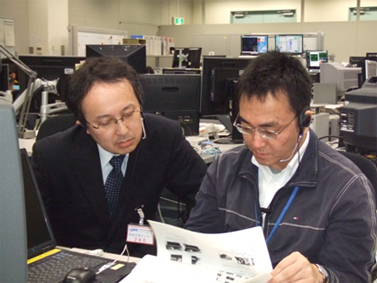This is an archive of information released in the past.
Disclaimer: It may contain broken links or outdated information. Some parts may not function in current web browsers.
*Visit https://humans-in-space.jaxa.jp/en/ for the latest information.

Experiment
- News
- Kibo Utilization Strategy
- Kibo Utilization Plan
- List of JAXA's Utilization Themes
- Experiment Facilities
- Space Environment Utilization
- Archive
Nanoskeleton Experiment Begins
* All times are Japan Standard Time (JST)
Production of High Performance Nanomaterials in Microgravity (Nanoskeleton), an experiment to create new nanomaterials, which uses the Cell Biology Experiment Facility (CBEF) in Kibo, began aboard the International Space Station (ISS).
Samples for the experiment were delivered to the ISS by the space shuttle Endeavour (STS-130) on February 8, 2010. Aboard the ISS, the samples were unpacked and stored in the station's refrigerator/freezer, MELFI. From March 1, Astronaut Noguchi began to prepare the samples (thawing), and began the experiment at 8:25 p.m. on March 2, 2010, after mixing and stirring the samples.
Nanoskelton is a new category of material, which shows improved properties of porous materials. The nanoskelton materials can be produced on the ground and used for development of photocatalyst. This experiment tries to create nanoskeleton materials, which the size of the pore (the part of the pipe-shaped hole) of the tube are widened, in the microgravity condition characterized by absence of gravity-induced convection, surfacing, and sedimentation. After the space-produced Nanoskelton samples are returned to the ground, the experiment team will compare the samples produced on the ground and the samples produced in a microgravity condition to evaluate effects of gravity on the production processes of the Nanoskelton materials. Using computer simulation, the team tries to determine an optimal condition for production of high quality Nanoskeleton materials.
The experiment will continue until March 12, 2010. The samples will be returned to the ground aboard the Space Shuttle Discovery (STS-131), on which Astronaut Yamazaki will fly.
Message from Experiment Team Member (Hideki Sakai, Associate Professor, Tokyo University of Science)
I thank JAXA and all those who have assisted the Nanoskeleton project. I was excited to see the experiment performed by Astronaut Noguchi aboard the ISS.
Nanoskeleton is produced using some chemical reactions. Therefore, sample analysis on the ground is very important. We will begin analysis and computer simulations as soon as the samples are returned to us.

Hideki Sakai, Associate Professor, Tokyo University of Science (left)
and Kenji Endo, Nanoskeleton Project manager, Toyko University of Science(right)
reviewing the experiment procedures that Astronaut Noguchi performs on orbit
*All times are Japan Standard Time (JST)
| Copyright 2007 Japan Aerospace Exploration Agency | Site Policy |